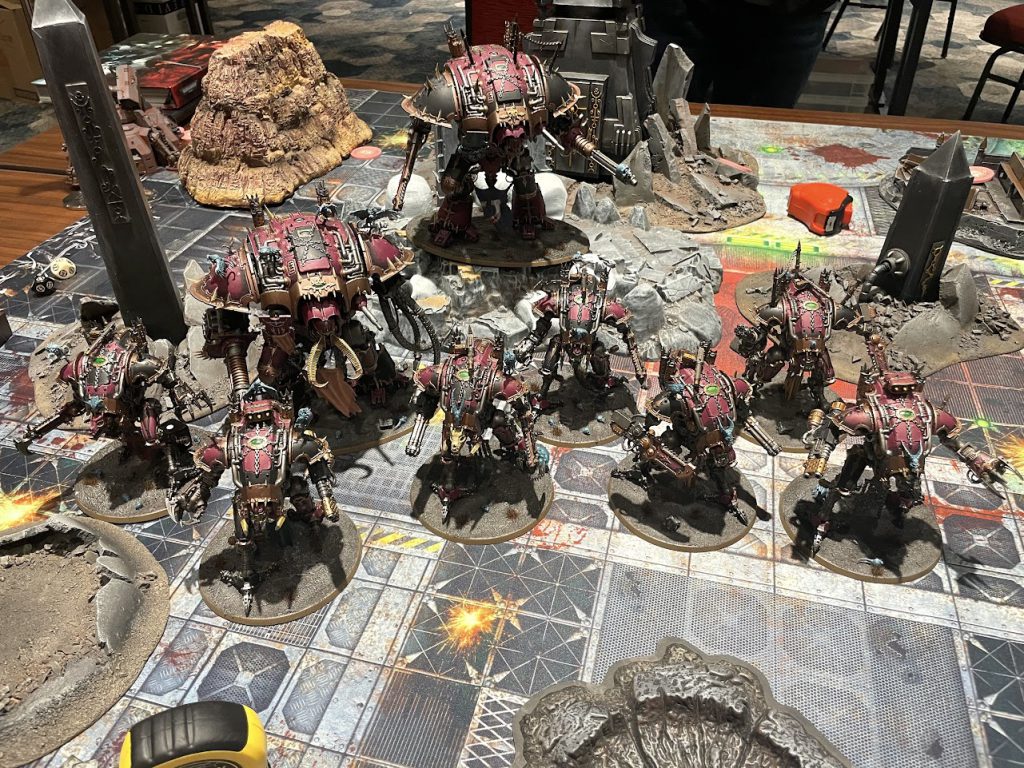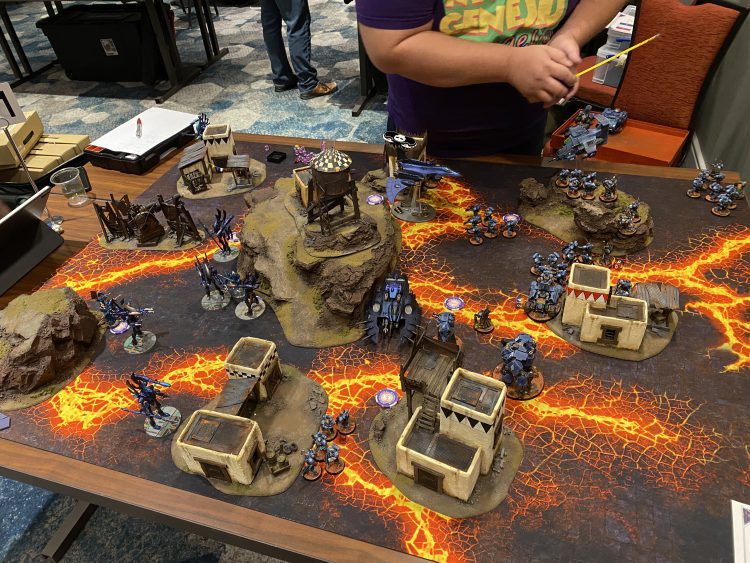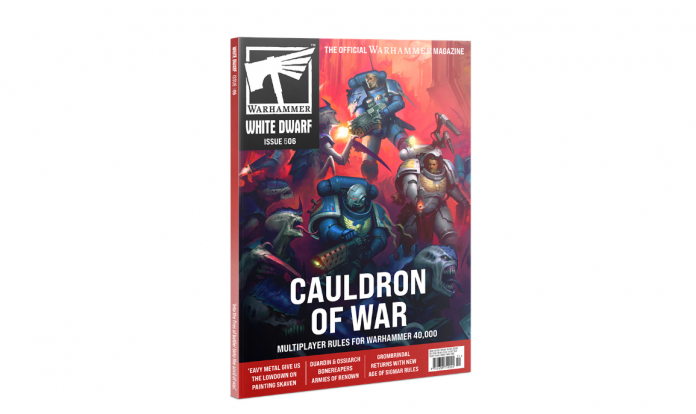This month’s issue of White Dwarf sees the publication of a new rules expansion for Warhammer 40k: Cauldron of War. These rules cover playing games of Warhammer 40,000 with more than two players, both playing team games with four or six players and playing free-for-all games with three or four players. Team games have been a part of Warhammer 40k forever, but we’ve long lacked formal rules for actually playing said games, and since eighth edition introduced resources like Command Points to the game having more rules in place to govern how these work with multiple players has become more important.
Games Workshop has taken a a swing at rules for these kinds of games before – most recently in the 9th edition Containment Crusade supplement. Those rules were kind of a dud, and were also tethered to Crusade and a ton of additional cruft, so it’s with great interest that we sat down to read and review the new rules. Did Games Workshop get it right this time, or is this an area where you should just stick to your homebrew rules? Let’s find out.
The Basics
Although they’re intertwined, there are essentially two sets of rules here, one for team games and one for free-for-all games. We’ll talk through each of these, as they’re very much separate in terms of how they handle things.
This expansion introduces a host of rules that you’ll be bolting on to the rules for a standard game, and those make things a bit more complicated, though not as much as it may look at first glance. There’s a whole page of “Core Concepts” in these rules which cover new things you need to know about playing these games, but these are largely pretty intuitive – they cover things like non-enemy, non-friendly units (your teammate’s units), how to handle sequencing and roll-offs with more than two players, and how teams handle phases of a turn. There’s one actually new concept here – the Underdog. In a free-for-all game, starting in the second battle round, the player with the fewest VP at the start of the battle round gains 1 CP. This doesn’t count toward their 1 CP max, and if players are tied for lowest, they each gain that CP.
Team Games
2v2 games and 2v1 games are super common ways to play among casual players, and while you can more or less piece together how to make these games work on your own, it’s good to have rules in place for them.
The biggest question in team games is how you handle a teammate’s units with regard to your own, and things like auras and effects. Cauldron of War rules establish that your teammate’s units are neither friendly nor enemy units and as such won’t benefit from those rules. Models can move over models that are not friendly models but have to take Desperate Escape tests if your falling back model isn’t TITANIC or FLY. Each player gains their own pool of CP and uses Stratagems independently, with no restrictions on Stratagem use per team.
Otherwise, games go how you’d expect – players on a team share a turn and complete phases at the same time. These are pretty basic rules, and they’re very much adequate from a get-you-by standpoint. They don’t address any of the corner case issues that mostly arise from two players bringing the same faction on a team and doing things like doubling up on Epic Heroes or once-per-game/turn Stratagems, but these admittedly aren’t a huge deal. These rules are fine.

Free-for-All Games
Where the real meat of this article lies is in the rules for Free-for-All games, which need a lot more help to make work, especially with the I-go-you-go structure of 40k rounds, which often mean one player has to potentially survive being destroyed by two or more opposing players instead of one. Let’s start with the most important part: Turns. Cauldron of War uses a roll-off system for turns in free-for-all games. That is, at the start of the game, players roll off to determine turn order for the game. From there, you’ll go in that order unless the mission specifies otherwise, and players gain 1 CP in each player’s Command phase, meaning that players will generate more CP per game in free-for-all games. When a rule calls for you to alternate with players, you’ll instead go in turn order making those decisions. There is no attacker or defender in free-for-all games.
Shooting and Combat
There are a number of changes these rules make to shooting and combat. For starters, you can shoot into combats which involve enemy units from multiple opposing players, but when you do so you take a -1 penalty to your hit and wound rolls. There are some carve-outs here for allies, which mostly come into play if players broker alliances – more on that in a bit.
Where things get really interesting is the Fight phase. In the Fight phase players take it in turns picking an eligible unit from their army and fighting with them, starting with the player whose turn is next. Units are eligible to fight if they’re either part of the active player’s army and within engagement range of an enemy unit, in Engagement range of one or more enemy units from the active player’s army, or if they made a charge move that turn. This means that while everyone could fight every turn, if your opponents have two units in combat on your turn and none of your units are around, they’re not eligible to fight. Standard rules more or less apply for who can make attacks, requiring a model either be within Engagement range of an enemy unit of their target, or in base-to-base contact of a friendly model in Engagement range of that enemy unit. You’re welcome to split targets as you see fit if you’re the active player, but if you’re not the active player, you can only fight or attack models in the active player’s army, so even if you’re eligible to fight you can’t get in free shots against another opponent.
This is a really great way to handle things, ensuring that players can’t get extra combats and aren’t open to extra attacks in the added turns they have to survive. At least, not in melee. Shooting is still an issue but there’s only so much you can do there.
One other wrinkle: You can’t use the Counter-offensive Stratagem. This is instead replaced by the Treacherous Offensive Stratagem, which can be used to fight after the first unit has fought – and only in that case. Multiple players can use this, and if they do they resolve those in player order, starting with the player who is going next.
Stratagems
In addition to Counter-Offensive being off the table, there are a few other key changes to the rules for Stratagems in free-for-all games. The biggest of these is that the Fire Overwatch Stratagem is also off-limits, having been replaced by the Treacherous Volley and Desperate Volley Stratagem. The former is used at the end of an opponent’s Movement phase to hit a unit that moved or was set up, while the latter is used like standard Overwatch against charging units. These are fine and have similar restrictions to Overwatch but note that neither is Fire Overwatch and so that will interfere with specific unit abilities like Dire Avengers – may be worth a ruling to make sure these work correctly.

Alliances
The other massive wrinkle added to free-for-all games is Alliances. There are three Stratagems which allow players to create and break alliances:
- Proffer Alliance is used in your Command phase on your Warlord (so you cannot do this if your warlord is dead) and if your opponent accepts, then until your next Command phase or until they break the alliance, models in their army become neutral to yours, neither friendly or enemy. If they decline you retain the CP spent on this Stratagem but count as having used the Stratagem.
- Bargain is used in your Command phase to basically offer a transfer of CP to an opponent in exchange for whatever terms you deem necessary. This is used more as a bribing tool and I’d suggest that if you’re playing in Crusade you should consider allowing RP to be on the table as well in these situations, just to give a player more to work with. There is nothing which forces an opponent to keep their word here.
- Break Alliance (3 CP) is used at the start of any phase on your Warlord to end an alliance immediately.
OK let’s talk about these. First off, I like that Breaking an Alliance costs a lot of CP and requires a Warlord on the table. That makes actually offering one significant – you can be betrayed, but it’s no simple matter to break that deal, and your opponent will likely telegraph the action by accumulating more CP than you’d normally expect. And Alliances only last until your next Command phase anyways, requiring that one or more of you keep them up if you want to keep going. That said, spending an ongoing 1 CP to do that is pretty steep.
Missions
The rules here offer six missions with free-for-all deployments for three and four players. There’s a teams deployment map but it’s just standard Dawn of War and if we’re honest you don’t need these missions for team games – just play whatever two player missions you want, competitive or otherwise, and have teams share VP and secondary objectives across players or whatever. It’s fine!
The three- and four-player deployment maps basically attempt to share equal splits of the table, with four-player free-for-all giving you corner zones spaced 20″ apart. The missions themselves put objective markers in the middle of the table, keeping them out of deployment zones. Otherwise they’re probably the weakest part of these rules – these missions feature only primary progressive objectives for holding objectives (no 50 VP cap) and allow primary scoring on the first turn, placing a massive premium on having units with scout moves and Infiltrators. Five of the missions also feature additional mission rules, with three of these adding an action to be completed which can score additional VP.
Although the rules for game sequence suggest that missions may change the turn order, nothing in these missions references that, so it may be the case that we have more missions coming in future issues. Otherwise it just feels like an oversight.
Folding These into Crusade
Crusade is regularly home to team and free-for-all games and opportunities for them, and so if you’re running a campaign it’s worth taking a look at these rules and understanding how you can use them to make for some fun dynamics. Generally, here are a few interesting things I’d recommend thinking about for your campaign games:
- Allow other resources to be used in Bargains. CP are fine but they’re not exactly a valuable resource to all armies and players. Requisition Points, Blackstone Fragments, Crusade Relics, and other Bafmodads are a much more interesting resource, and I’d suggest letting your players put those up for grabs as well in bargains made in-game.
- Tenuous Alliances. If you’re letting players run team games, consider this: Have your team games be Free-for-All games where players on each team start the game in an Alliance that does not end unless one player breaks it via Stratagem, and splitting up turn order so that players alternate between teams. This creates the opportunity for players to break alliances and double-cross each other mid-game in delightful ways. Alternatively, consider letting team games start this way and if players choose to break alliance mid-game (at the end of any battle round) the game then immediately shifts into a free-for-all with players rolling off to determine order. This one will need a lot more work to handle rules-wise, so I’d suggest going with the “team games are actually FFA games with pre-allied players” approach.
- Split and Singular Rewards. Think about how you want to dole out Crusade rewards in team or FFA games. Generally in team games I let each player on the winning team take an award, but if you’re going with tenuous alliances that can be singular, and you’ll force players to debate or fight over it.
- Keep Games Small. More players means longer games. You’ll want to keep your games running at smaller points values, especially if you’re doing free-for-all games. I find that experienced players can still run a four-player FFA in about three hours, but you’re going to add a ton of time if you go for larger point values and more players. I’d generally top out at 1,500 points per player in FFA unless I was doing something more like an Apocalypse batt.e
- Turn bidding. I’m going to plug bidding on turn order again because I like it so much. When we do FFA games we start the game with each player receiving a chip numbered 1 through 5. At the beginning of each round players blind bid one of their chips, and then turn order is based on the bid value, from highest to lowest, with roll-offs to break ties. Bid tokens are lost. This gives players some control over when they’ll be going and can create some fun moments and tension. Also you can let players offer token trades in Bargains.
- Diplomacy. The ability to do diplomacy opens up the opportunity to have custom Battle Traits and crusade rewards that work around these rules – if you’re homebrewing this is a cool way to create rules for things like T’au diplomats, and you should work with your players to create opportunities to forge alliances and determine what that means round-to-round. There’s a lot of fun opportunities to do things with more small teams of players who are closely aligned by faction instead of doing two big imperium/chaos groups. Think about your narrative goals for the campaign and how you can encourage brokering and breaking alliances!
Final Verdict
These rules are pretty good, but that comes with some caveats. The teams rules are just fine, and as long as you aren’t worried about some weird needlessly competitive edge cases doubling up on the same units, you’ll be fine. The free-for-all rules on the other hand are a much more necessary addition, and they get about 90% of the way there, in my estimation. I’m not a huge fan of roll-offs for turn order – I’ve long been a proponent of using a bidding system for turn order – but it works OK enough here. The alliance rules are pretty solid outside of the CP issue already mentioned and making it cost 3 CP to break an Alliance early is a good touch.
On the whole, I think these are worth looking at for a campaign, Crusade or otherwise, and if you’re doing a lot of multiplayer games, give these a look. It’s clear that a lot of work went into these and the results are a clear improvement over Games Workshop’s last attempt.
Have any questions or feedback? Drop us a note in the comments below or email us at contact@goonhammer.com. Want articles like this linked in your inbox every Monday morning? Sign up for our newsletter. And don’t forget that you can support us on Patreon for backer rewards like early video content, Administratum access, an ad-free experience on our website and more.


